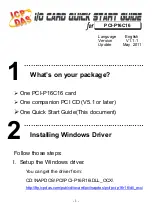
4
Keypad Data and Tamper Monitor Signalling
Keypad data and tamper monitor status are transmitted on the data lines as 8-bit blocks. They are encoded and sent using the
same signaling method as selected for the card data output (clock/data or data 1/data 0). If Dorado 8-bit keypad data format is
required order the -K1 option. Card data, tamper status data, and keypad data blocks are separated by a minimum of 100
milliseconds. See following for codes:
10110000 - 0 (ASCII ‘0’, odd parity, MSB first) 00110001 - 1 (ASCII ‘1’, ...)
00110010 - 2 (ASCII ‘2’, ...)
10110011 - 3 (ACSII ‘3’, ...)
00110100 - 4 (ASCII ‘4’, ...)
10110101 - 5 (ASCII ‘5’, ...)
10110110 - 6 (ASCII ‘6’, ...)
00110111 - 7 (ASCII ‘7’, ...)
00111000 - 8 (ASCII ‘8’, ...)
10111001 - 9 (ASCII ‘9’, ...)
00101010 - * (ASCII ‘*’, ...)
00100011 - # (ASCII ‘#’, ...)
11010011 - SAFE (ASCII 'S', ...)
01010100 - ALARM (ASCII ‘T’, ...)
Reader Verification
The reader performs a self-test when power is first applied to the unit. If power-on test is successfully completed, The reader
will turn on both LEDs for approximately 1 second and sound the buzzer for 1 short beep. Then the reader is ready for normal
operation.
If further verification of the reader hardware is needed, the reader may be temporarily set to format T. With this format selected,
the reader will read and verify standard ANSI track 2 encoded card. If no read error is detected, the green LED will flash.
Otherwise, the red LED will flash and the buzzer will sound two short beeps to indicate an error. The LED input can be used
to verify the LED function; and the buzzer input for the buzzer function. For the SMR20, the reader will echo a key press with a
brief flash of both LEDs and a short beep of the buzzer. Reset to the required format for normal operation after test.
Maintenance
The readers are designed to provide continuous service with minimal routine maintenance. However, contaminants (such as
magnetic oxides from badges and dirt) tend to accumulate on the read head. Without regular cleaning, these contaminants will
shorten the read head life and increase the probability of card read error. A maintenance schedule should be developed base
on the card reader environment (dirty or clean) and the usage frequency (light traffic or heavy traffic). Extreme case may require
daily cleaning.
Head cleaning may be done by using a disposable, pre-saturated magnetic head cleaning card. These cards are readily
obtainable from a number of sources (e.g. Clean Team Co., www.cleanteam.com, 800-888-8830; KIC Products,
www.kicproducts.com, 207-514-7030; System ID, www.systemid.com 888-648-4452).
The reader exterior surface is covered with high strength polymer and polyester membrane. It may be cleaned with a soft cloth
and mild detergent if required.
The reader is for use in low voltage, class 2 circuits only.
Highlighted states are
compatible with the
CT5000 or the WRI.


























